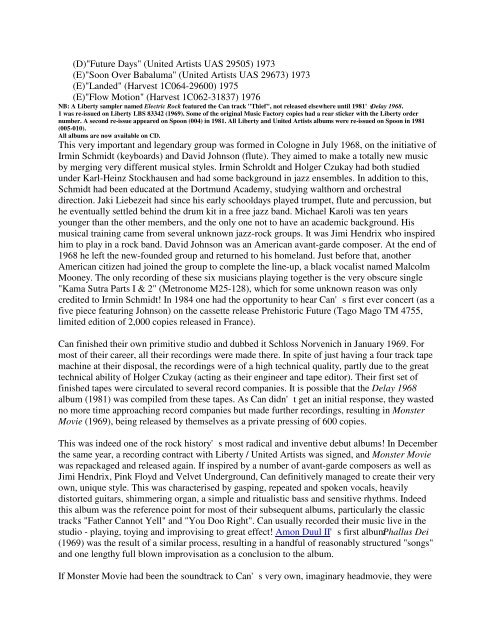Cosmic Dreams at Play - Stoned Circus radio show - Free
Cosmic Dreams at Play - Stoned Circus radio show - Free
Cosmic Dreams at Play - Stoned Circus radio show - Free
Create successful ePaper yourself
Turn your PDF publications into a flip-book with our unique Google optimized e-Paper software.
(D)"Future Days" (United Artists UAS 29505) 1973<br />
(E)"Soon Over Babaluma" (United Artists UAS 29673) 1973<br />
(E)"Landed" (Harvest 1C064-29600) 1975<br />
(E)"Flow Motion" (Harvest 1C062-31837) 1976<br />
NB: A Liberty sampler named Electric Rock fe<strong>at</strong>ured the Can track "Thief", not released elsewhere until 1981's Delay 1968.<br />
1 was re-issued on Liberty LBS 83342 (1969). Some of the original Music Factory copies had a rear sticker with the Liberty order<br />
number. A second re-issue appeared on Spoon (004) in 1981. All Liberty and United Artists albums were re-issued on Spoon in 1981<br />
(005-010).<br />
All albums are now available on CD.<br />
This very important and legendary group was formed in Cologne in July 1968, on the initi<strong>at</strong>ive of<br />
Irmin Schmidt (keyboards) and David Johnson (flute). They aimed to make a totally new music<br />
by merging very different musical styles. Irmin Schroldt and Holger Czukay had both studied<br />
under Karl-Heinz Stockhausen and had some background in jazz ensembles. In addition to this,<br />
Schmidt had been educ<strong>at</strong>ed <strong>at</strong> the Dortmund Academy, studying walthorn and orchestral<br />
direction. Jaki Liebezeit had since his early schooldays played trumpet, flute and percussion, but<br />
he eventually settled behind the drum kit in a free jazz band. Michael Karoli was ten years<br />
younger than the other members, and the only one not to have an academic background. His<br />
musical training came from several unknown jazz-rock groups. It was Jimi Hendrix who inspired<br />
him to play in a rock band. David Johnson was an American avant-garde composer. At the end of<br />
1968 he left the new-founded group and returned to his homeland. Just before th<strong>at</strong>, another<br />
American citizen had joined the group to complete the line-up, a black vocalist named Malcolm<br />
Mooney. The only recording of these six musicians playing together is the very obscure single<br />
"Kama Sutra Parts I & 2" (Metronome M25-128), which for some unknown reason was only<br />
credited to Irmin Schmidt! In 1984 one had the opportunity to hear Can's first ever concert (as a<br />
five piece fe<strong>at</strong>uring Johnson) on the cassette release Prehistoric Future (Tago Mago TM 4755,<br />
limited edition of 2,000 copies released in France).<br />
Can finished their own primitive studio and dubbed it Schloss Norvenich in January 1969. For<br />
most of their career, all their recordings were made there. In spite of just having a four track tape<br />
machine <strong>at</strong> their disposal, the recordings were of a high technical quality, partly due to the gre<strong>at</strong><br />
technical ability of Holger Czukay (acting as their engineer and tape editor). Their first set of<br />
finished tapes were circul<strong>at</strong>ed to several record companies. It is possible th<strong>at</strong> the Delay 1968<br />
album (1981) was compiled from these tapes. As Can didn't get an initial response, they wasted<br />
no more time approaching record companies but made further recordings, resulting in Monster<br />
Movie (1969), being released by themselves as a priv<strong>at</strong>e pressing of 600 copies.<br />
This was indeed one of the rock history's most radical and inventive debut albums! In December<br />
the same year, a recording contract with Liberty / United Artists was signed, and Monster Movie<br />
was repackaged and released again. If inspired by a number of avant-garde composers as well as<br />
Jimi Hendrix, Pink Floyd and Velvet Underground, Can definitively managed to cre<strong>at</strong>e their very<br />
own, unique style. This was characterised by gasping, repe<strong>at</strong>ed and spoken vocals, heavily<br />
distorted guitars, shimmering organ, a simple and ritualistic bass and sensitive rhythms. Indeed<br />
this album was the reference point for most of their subsequent albums, particularly the classic<br />
tracks "F<strong>at</strong>her Cannot Yell" and "You Doo Right". Can usually recorded their music live in the<br />
studio - playing, toying and improvising to gre<strong>at</strong> effect! Amon Duul II's first album Phallus Dei<br />
(1969) was the result of a similar process, resulting in a handful of reasonably structured "songs"<br />
and one lengthy full blown improvis<strong>at</strong>ion as a conclusion to the album.<br />
If Monster Movie had been the soundtrack to Can's very own, imaginary headmovie, they were


